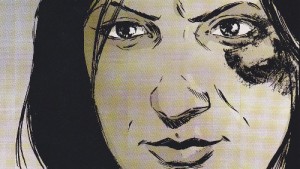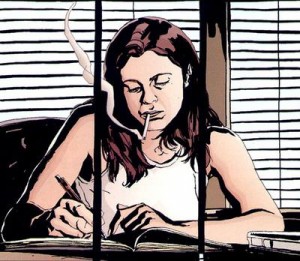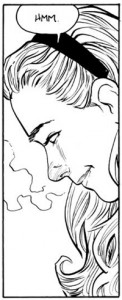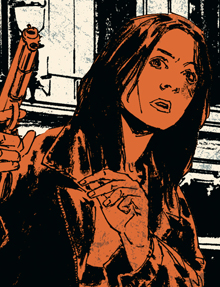I know I’ve mentioned it before, but I really enjoy stories that feature women as their protagonist. For whatever reason, I find the struggles they go through and the observations they make just more appealing and interesting than my steady diet of costumed guys beating up in other costumed guys. Hey, I enjoy a Bendis-fueled Peter Parker quip as much as anyone else, but right now I find myself drawn less to the rigors of typical male-focused fare and more to stories of women making it for themselves in a world order so often defined by men.
If there were a “best female comics heroine” category, just around, available for the bestowing, you’d be hard pressed to find better candidates than Julie Martin in Echo, Dex Parios in Stumptown and Jessica Jones in Alias. Each is a strong-willed character doing hard work, struggling against a variety of challenges, both professional and personal, well before the stories begin. As I have been poring over these books, I am struck by how much more human these characters tend to be. And, no, it’s not necessarily because these stories feature women as their heroes – men have all kinds of problems, personal and professional, as you well know – but I do think that there is an element of personal emotional engagement in these stories that you just don’t see in a Spider-Man book. Let’s take a breath and discuss the three stories, then get back to what they have in common.
I have been wanting to write about Stumptown for months now. I had originally picked it up in issues, then fell behind and figured I’d wait until the trade came out to finish up the story, and boy, am I happy I did. Even if you have the issues, if you really like the book, you may want to invest in this oversize trade hardcover – it’s a solid, gorgeous book that you’ll want to keep around and others will want to borrow. You will let them borrow it, but you’ll not rest easy until it’s back home.
Stumptown, which takes place in and around Portland, Oregon, introduces us to Dex Parios, a private investigator who is struggling to pay her bills and her debts, of which she has many, given that she has a gambling problem. I really like Dex–she’s just one of those characters that is so far from perfect that she lingers with you long after you’ve put the book down. You get a sense that she is a capable investigator, with the right skills and intentions, who finds herself in under her head at the worst possible times. This girl is not afraid to get in a fight, which is great–but, for the most part, that just means she’s the one getting her butt kicked. There’s a great scene of her coyly picking up on the doctor helping her with her injuries that really helps us understand this character from the get-go: hey, you’ve already seen me in my bra, are you single?
Make no mistake, Dex is hard boiled and feisty, ready with a quip (or an upper cut) depending on the situation. However, we soon see a different side of her the moment she gets home and you realize that she’s also taking care of her mentally challenged brother, which, you know sounds like a stereotype (“hard fisted–with a heart of gold”), the dichotomy really works here, it just feels…real, at least the way Rucka and Southworth deliver it.
When I think about Stumptown, I think less about the actual story (which is layered and engaging) and more about the characters and the settings, thanks in large part to Matt Southworth’s fantastic, just fantastic, art. While it is tempting to compare him to Michael Lark, he’s got more than enough talent for his work to stand on its own. With these kinds of stories, it is imperative that the artist is able to give us enough “acting” in his drawings for us to notice the kinds of facial ticks and mannerisms that the main character would look for when having a conversation. Even as I think back on the story now, months after reading it, I remember the faces and expressions of the characters, especially in both dramatic and peaceful moments, quite vividly. As with any good mystery, the background is a character as well, and Southworth’s renderings of Portland are wonderfully detailed, but never mechanical or overwrought. You flip through the book and can see his range, from quiet moments of nature to bare knuckled fist fights. And while his work is wonderfully detailed, it ever overwhelms the eye–you have enough wiggle room to let your mind fill in the gaps between the lines, which I think is a big reason I am able to recall so many moments so clearly.
Stumptown is a story of emotional and physical backbone, of trust, betrayal and beleaguered redemption. While the events of the story are intriguing in and of themselves, it’s really the way Dex deals with the events that makes the story so compelling. Part of me wishes she could drop in on the Marvel or DC universe, just to shake things up a bit – she’s one of those characters that just leaps off the page and stays in your head.
Alias is one of those stories that just gets better each time you read it. Jessica Jones is such an established character in the Marvel Universe that it’s kind of awesome to read about her before she got “famous” – I know that sounds weird, but that’s the only way I can think about it. Readers who have never read Alias might be surprised to find out that before the series came out, Jessica Jones never appeared before in the Marvel Universe, though her backstory has filled out quite a bit since the series, which was the first to appear under Marvel’s MAX imprint, ten years ago.
The setup is deliciously simple: Jessica Jones, who used to be a superhero named Jewel, has hung up her spandex and is working as a private investigator. It is tempting to make comparisons between Dex and Jessica – and I will! – but suffice to say that this 28 issue series was about a lot more than a few missing person’s cases.
Without getting too far into the specifics, Brian Michael Bendis and Michael Gaydos weave together a series of really compelling mysteries throughout the series, each of which force Jessica to come to terms with her own frustrating issues and anguished past. On the surface, she is, well, kind of a wreck. She’s a heavy drinker, she’s moody, she’s not taking care of herself…she just not happy. Over the series, we get a better understanding of what brought her to this point, how a person with powers far beyond moral men would choose to give them up. And while that is indeed interesting, Bendis does not make this the focus of the book – this is a story about a private investigator, and we are treated to some really great moments, including a graphic layout structure that is used whenever Jessica is getting the details of a new case. Literally, whenever she gets a new case, the page is laid out exactly the same, with Jessica listening at the top of the frame, while the story of the case so far is laid out below. I found myself reacting differently each time I saw this device used, and realized that I had kind of gotten used to it, that I was focusing more on the details, just like Jessica would be doing during the conversation. It is a subtle trick but I gotta tell ya: I wish Bendis would use it once in an Avengers title, when someone is telling Jessica a story – it would be a real treat.
I could write an totally separate article just on the art of Alias and how it is used. In addition to Michael Gaydos’ incredible work, you see different artists contributing to the book to differentiate between the present day and other times, other places, namely Mark Bagley and Rick Mays. David Mack’s covers are breathtaking; I remember picking up these issues when they came out – I was just drawn these covers, which are just hauntingly beautiful (he also does some interior work as well, supplying a scrapbook that a missing teenager leaves behind) – there was nothing like that on the shelves at the time, you just had to pick up the book.
But it’s Jessica Jones that keeps bringing me back. It’s Jessica Jones who has some of the most intense personal traumas – and recoveries – in comics that really solidify this story as one of Bendis’s best comics ever. Jessica is such a devastatingly real person to me. Yes, she’s kind of screwed up and depressed, but when she smiles, when she laughs, she lights up the room. We’ve all had friends like this, you know? The ones who are going through a tough time, who need help, but just don’t know how to ask for it? Who is keeping something back from you, no matter how many times you offer to help? Who you ask if they are okay, and they smile, tell you not to worry, and crack a joke about your date? Jessica’s the friend you want to help…if only she’d let you.
I must hasten to make it clear that as messed up and frustrated Jessica is, she also kicks some serious ass throughout the book – she does have superpowers, remember? There are a lot of really funny moments throughout the book, alongside some fun cameos by Matt Murdock, Captain America, Luke Cage and others. There are some quiet scenes, really touching relationship scenes, that are just so simple and so good, that when they happen you just find yourself…sitting. Sitting and being quiet..if only for a second, letting the moment settle in. A comic that gives you pause is a gift.
The unwilling/unwitting superhero is a pretty common trope, but I daresay that Echo‘s Julie Martin is one of the most entertaining examples of this kind of protagonist that we’ve seen in years. A classic case of “wrong place, wrong time,” Julie ends up in the middle of a classic corporation vs. government vs. anti-establishment bikers chase with a dash of “end of the world” thrown in for good measure. Like the other books I’ve mentioned, Echo has been an iFanboy favorite for years now, but with the release of the trade, now is the time to check out Terry Moore’s 30 issue masterwork.
Echo actually introduces us two (well, three, if you wanna get technical) engaging and memorable women, each with complex and varied lives, fears and hopes. The thrill ride that is Echo would take an article of its own to go through, but suffice to say that this is so much more than a case of top secret technology falling into the “wrong” hands. Like Dex and Jessica, Julie starts out the story kind of having a rough time–she’s behind on her bills, the hot water has been turned off, she’s in the middle of a divorce that she does not want…it’s a rough time. Like Dex, she has a loved one, her sister, who she does her best to take care of, and, like Jessica, she has to learn to accept herself before she can really be herself with others. Ivy, a private “fixer” who is hired to help find Julie deserves special mention as well. When we first meet her, we take her for the standard spook, with special training and firearms, who serves as a way of making Julie’s life more difficult. However, as the story progresses, their stories come together in wonderfully comical and heartfelt ways…it is a joy to see how these two headstrong people come together.
Now, I haven’t read Strangers in Paradise. I know, I know – I just haven’t gotten around to it, okay? So, while all y’all might be familiar with Terry Moore’s work, I must say that I found his artwork to be just stunningly beautiful. And I’m not saying that because he knows how to draw attractive men and women. No–it’s so much more than that. He knows how to draw realistic people with so few lines…the extra weight in the chin, or that odd little tuft in your belly that seems to only be there when you are sitting. What he does with lips and eyes…he creates emotional beings with an economy of lines that, for me, borders on the profound. I’m not kidding – you could take away the word balloons in the majority of these pages and you wouldn’t miss them. His ability to generate real emotion, in black and white, is deeply impressive.
Echo is a lot of fun. There are lots and lots of really great characters, and Moore does that wonderful thing of making even the “bad” guys relatable. His art might be black and white, but his characters are not. (Sorry, I couldn’t resist.) Echo wrestles with huge ideas, drawing together science, religion, math and biology without hitting you over the head with it. At its core, though, is how events bring people together, how the bonds we make with other people result in surprises that define our lives.
So, patient reader, why these three trades? Why attempt to write about Dex, Jessica and Julie’s stories in one far-reaching, carpal-tunnel inducing article? It’s more than me writing, “Hey, check this out: these three books have female characters that are kind of screw-ups but end up being awesome heroes.” I mean, that’s true, but so what?
These characters are women, through and through. And though the writers behind these characters are male, I think they do a terrific job of showing the reader how a woman will approach situations differently than a man. What they notice, what they talk about, how they react to men, how they react to other women, how they hold a child, how they flirt, how they make a drink, how they go in for a kiss…it’s just different, you know? And I appreciate the writers turning these kinds of stories on their head and choosing a different route.
These characters share a wonderful frankness and strength. These women are not your “sugar and spice and everything nice” variety. These are strong women, with fully realized points of view and they aren’t looking for your sympathy, or even your help. And while it is tempting to suggest that these books wouldn’t be as good if these characters were named Jim or Jesse, that’s really not helpful either. Julie, Dex and Jessica are strong, amazing characters first, the fact they are women just make the story a bit more interesting, to me, in terms of how the characters think and how they react to the events around them. There’s humor here, knowing looks, quiet smirks – small touches that breathe so much life into moments, acknowledgement that women do look at things differently. It is these kinds of flourishes that comics do so well, when art and writing blend together to help the audience experience life in a new light – which is why I read comics.
There were a few years in New York when I was really broke and really just dong whatever I could do to make ends meet. I remember thinking that I was truly “growing up” at that time–I could not rely on anyone else to help me out, I had to get through the rough patch on my own. When I think about these characters I realize that while I am intrigued at how someone’s sex can inform the way to they go through life, what I am truly drawn to is that these characters were in the same kind of situation. Life was rough and they were doing the best they could with what they had, and with a little bit of patience, forgiveness and a willingness to let others help out, that things really could get better.
Alias, Echo and Stumptown are very modern stories that feature very modern heroines. They celebrate the elements that make comics fun, the action, the big ideas, the high stakes, while balancing out these thrills with complex intellectual and emotional themes that will bring you back to the bookshelf time and time again, and should be part of your life’s collection.
Mike Romo is an actor in LA who really, really loves the new iFanboy editing tools. Check him out on twitter, Facebook or drop him an email.







Hey, love the article and I think these three heroines are awesome, and I’ve read all three stories. I wanted to start with that because I hate to point out that you accidentally called Jessica Jones “Jennifer” in the second paragraph of the article. Anyway, I love the article and your work! Keep it up, and I’d like to hear about some other strong female characters out there. I’d put my money on Tara Chace any day, she needs her own article.
Your second paragraph mentions a Jennifer Jones, as opposed to Jessica. So much Marvel alliteration.
Interesting article.
Well written as always.
But it brings to mind a question.
I think one thing the comics community in general has to get over
Is the idea of gender and race being a distinction.
Now I have voiced my opinion on some of that regarding strictly sticking to source material..
But aside from that tangent I think there is a prevailing insinuation even here that men are more brutish and simpler than all women characters.
A woman can be kick ass brutal – and man can be the sensitive thinker.
And the reverse. And then the reverse of that and so on.
We talk a lot about equality here and only characters mattering but to me this list would speak a lot more strongly
for that if it had just been- “Here are some of my favorite protagonists” And then they just happen to women.
It’s similar to here are my favorite female writers- why should that even be mentioned-
What about writing- should call into question a person gender when that job is to imagine all sorts of people outside of the writers own head.
Just writer will do.- Just artist is sufficient.
Until it isn’t highlighted it will never be equal.
And here- I am asking everyone- why should there be a label at all involved.
when something is under represented, like strong female characters or visible minority heroes, quality depictions sometimes need to be highlighted in articles like these in order to bring greater attention to the good work being done by the creators who write/draw them. there’s nothing wrong with promoting good work in hopes that others will be inspired to follow that example
“…I find the struggles they go through and the observations they make just more appealing and interesting than my steady diet of costumed guys beating up in other costumed guys.”
While I enjoy my costume guys (that sounds funny), I totally agree with this statement. I can’t wait to see how the AKA Jessica Jones live action show turns out. Plus, the Stumptown comics are coming soon. I hear the next story is about Dex going to Long Beach trying to catch a sex addict who may be linked to a series of rapes. It’s called, “Dex on the Beach.”
While that’s not true…it totally should be.
Nice post Mike!
I haven’t read any of these. I guess I know what I should read next.
hi guys–
looked like the Jennifer/Jessica was corrected by the iFanboy editorial staff. Sorry about that! My sisters-in-laws names are Jessica and Jennifer as well and I do it with them, too.
Thanks for reading this, by the way. I know it was long one this time around (which is why I don’t do them more than 2-3x a year, if that), but I just could’t get these characters out of my head!!
Best excuse for a typo ever.
Brilliant article Mike! Stumptown is my book of the year so far. Can’t wait for Rucka to get back to Dex again.
Alias is what got me back into comics after being away for a few years. The first issue was unlike anything I’d come across, and I only picked it up on a whim after seeing it was written by that Bendis guy who wrote that great Sam and Twitch series.
I enjoyed Echo despite there being a bit of a lull around the second or third trade. @mike: You really should try SIP. Ron’s enthusiasm in both audio and video shows convinced me to pick up the pocketbook editions last year. One of the best things I’ve read, to the extent that I put off reading the last book because I didn’t want to say goodbye to the characters. Easily the greatest slice-of-life comic I’ve read.
Carrie Stetko in Whiteout was pretty great, too. Loved Alias. Need to read Stumptown. Will check out Echo. Good article.
Good choices, but would like to give an honarable mention to Megan (Local) and Barbara Thorson (I Kill Giants).
*honorable
Great suggestions, guys. Megan was amazing, I totally agree and I need to read Whiteout and I have the first two trades of “Strangers in Paradise” and I promise to get on it…
The character of Dex is great but the art in the final issues of Stumptown left a lot to be desired.
If I were asked to name the three best male writers of female characters in comics I would probably come up with Bendis, Rucka and Moore. Anyone looking to add to this list can just look at other work by these guys as a good starting point.
The only thing wrong with the article — which I loved — is that I’ve already read these three books. I was lucky: Alias is one of the first comics I ever read, and the first thing series I read written by Bendis — what a stunning introduction to comics.